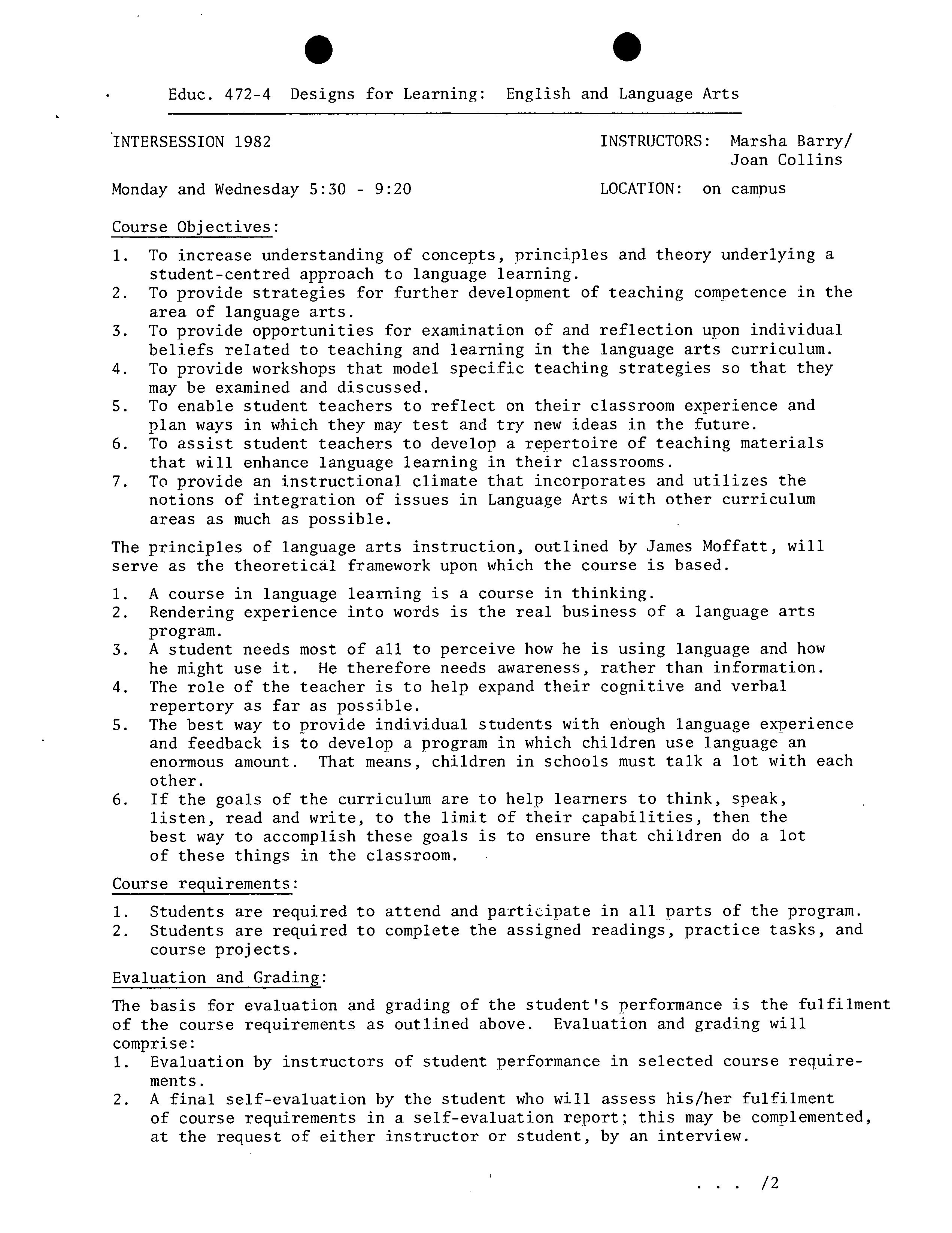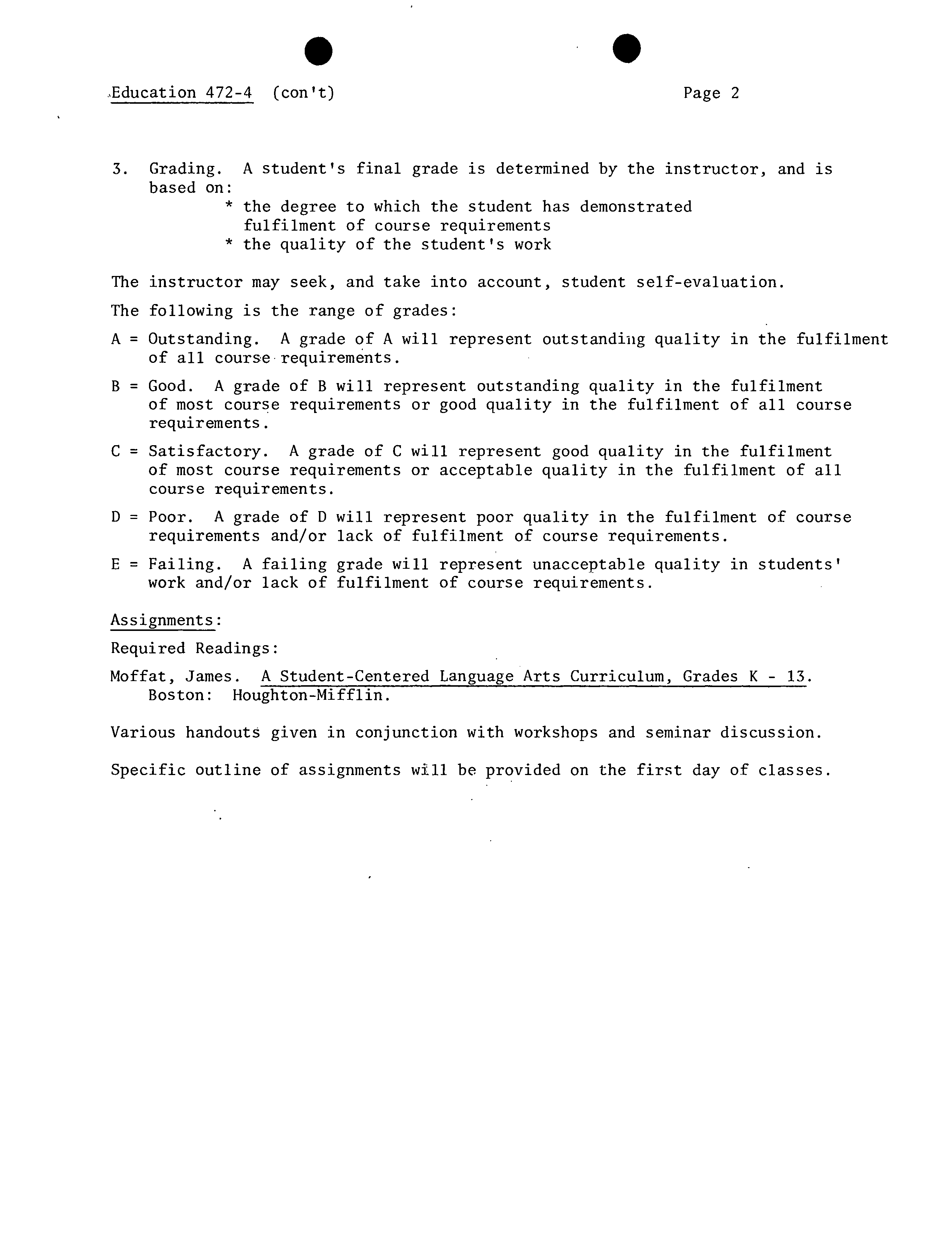.
Educ. 472-4 Designs for Learning: English and Language Arts
INTERSESSION 1982 ?
INSTRUCTORS: Marsha Barry!
Joan Collins
Monday and Wednesday 5:30 - 9:20
?
LOCATION: on campus
Course Objectives:
1.
To increase understanding of concepts, principles and theory underlying a
student-centred approach to language learning.
2.
To provide strategies for further development of teaching competence in the
area of language arts.
3.
To provide opportunities for examination of and reflection upon individual
beliefs related to teaching and learning in the language arts curriculum.
4.
To provide workshops that model specific teaching strategies so that they
may be examined and discussed.
S. To enable student teachers to reflect on their classroom experience and
T
lan ways in which they may test and try new ideas in the future.
6.
To assist student teachers to develop a repertoire of teaching materials
that will enhance language learning in their classrooms.
7.
To provide an instructional climate that incorporates and utilizes the
notions of integration of issues in Language Arts with other curriculum
areas as much as possible.
The principles of language arts instruction, outlined by James Moffatt, will
serve as the theoretical framework upon which the course is based.
1.
A course in language learning is a course in thinking.
2.
Rendering experience into words is the real business of a language arts
program.
3.
A student needs most of all to perceive how he is using language and how
he might use it. He therefore needs awareness, rather than information.
4.
The role of the teacher is to help expand their cognitive and verbal
repertory as far as possible.
S. The best way to provide individual students with enough language experience
and feedback is to develop a program in which children use language an
enormous amount. That means, children in schools must talk a lot with each
other.
6. If the goals of the curriculum are to help learners to think, speak,
listen, read and write, to the limit of their capabilities, then the
best way to accomplish these goals is to ensure that children do a lot
of these things in the classroom.
Course requirements:
1.
Students are required to attend and participate in all parts of the program.
2.
Students are required to complete the assigned readings, practice tasks, and
course projects.
Evaluation and Grading:
The basis for evaluation and grading of the student's performance is the fulfilment
of the course requirements as outlined above. Evaluation and grading will
comprise:
1.
Evaluation by instructors of student performance in selected course require-
ments.
2.
A final self-evaluation by the student who will assess his/her fulfilment
of course requirements in a self-evaluation report; this may be complemented,
at the request of either instructor or student, by an interview.
/2
?
.
?
I
?
Education 472-4 (con't)
?
Page 2
3. Grading. A student's final grade is determined by the instructor, and is
based on:
• the degree to which the student has demonstrated
fulfilment of course requirements
• the quality of the student's work
The instructor may seek, and take into account, student self-evaluation.
The following is the range of grades:
A = Outstanding. A grade of A will represent outstanding quality in the fulfilment
of all course requirements.
B = Good. A grade of B will represent outstanding quality in the fulfilment
of most course requirements or good quality in the fulfilment of all course
requirements.
C = Satisfactory. A grade of C will represent good quality in the fulfilment
of most course requirements or acceptable quality in the fulfilment of all
course requirements.
D = Poor. A grade of D will represent poor quality in the fulfilment of course
requirements and/or lack of fulfilment of course requirements.
E = Failing. A failing grade will represent unacceptable quality in students'
work and/or lack of fulfilment of course requirements.
Assignments:
Required Readings:
Moffat, James. A Student-Centered Language Arts Curriculum, Grades K - 13.
Boston: Houghton-Mifflin.
Various handouts given in conjunction with workshops and seminar discussion.
Specific outline of assignments will be provided on the first day of classes.


